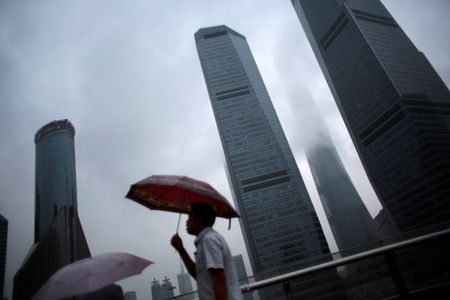By Xiaoyi Shao and Koh Gui Qing
BEIJING (Reuters) - China's foreign direct investment in August fell to a low not seen in at least 2-1/2 years, underscoring the challenges to growth facing the world's second-biggest economy.
The weak investment data comes as China's economic growth appears to be hitting a soft patch after a bounce in June, with indicators ranging from imports to industrial output and investment all pointing to sluggish activity.
China attracted $7.2 billion in foreign direct investment in August, the Commerce Ministry said on Tuesday, down 14 percent from a year earlier and at a level not seen since at least February 2012.
That left China with $78.3 billion of FDI in the first eight months of 2014, down 1.8 percent from a year earlier.
"It reflects the downward pressure on the manufacturing sector," said Zhou Hao, an ANZ economist. "The manufacturing sector has not been doing well so it's logical that companies are reducing their investment."
FDI is an important gauge of the health of the external economy, to which China's vast factory sector is oriented, but it is a small contributor to overall capital flows compared with exports, which were worth about $2 trillion in 2013.
China startled global investors last weekend when it released data that showed factory output growing at its slackest pace in six years in August, stoking fears its economy was sliding deeper into a bruising downturn and causing some economists to trim their 2014 growth forecasts.
And even though data suggests that sluggish domestic demand is now a bigger drag on China's economy compared with buoyant exports, Shen Danyang, spokesman at the commerce ministry, said the trade sector too is vulnerable to a cooldown.
"We are not sure foreign trade can certainly sustain the high growth rate seen recently in coming months because there are still a lot of uncertain factors in external and domestic markets," Shen told reporters at a monthly media briefing.
Helped by a firmer U.S. economy, China's exports have picked up recently to be a rare source of cheer in an otherwise gloomy data landscape.
Figures this month showed exports in August jumped 9.4 percent from a year earlier while imports fell for the second consecutive month, raising concerns that tepid domestic demand exacerbated by a cooling housing market was increasingly weighing on the economy.
MORE INTEREST IN SERVICES
FDI inflows in China have maintained steady growth every year since the country joined the World Trade Organization in 2001. Inflows reached a record high of $118 billion in 2013.
Defending China's ongoing antitrust investigations that have involved at least 30 foreign companies including Microsoft (O:MSFT), Shen said the decline in FDI was not linked to the country's anti-monopoly probes.
Chinese authorities saw no abnormal outflows in foreign capital, Shen said.
In the first eight months of the year, China's services sector attracted $43.3 billion of FDI, up 8.9 percent from a year ago and faring much better than the manufacturing industry, where FDI dropped 15.7 percent from a year ago to $27.5 billion.
Shen said China would continue to support imports of advanced technology and equipment and was studying ways to increase the financial aid for such importers.
Among the 10 countries that were the biggest sources of China's FDI, investment from South Korea surged 31.3 percent on an annual basis and that from Britain leapt 18.9 percent.
In contrast, investment from Japan plunged 43.3 percent from a year earlier while FDI from the United States and European Union dropped between 17-18 percent each.

China's non-financial direct outbound investment rose 15.3 percent in the first eight months from a year earlier to $65.2 billion.
(Editing by Jacqueline Wong)
